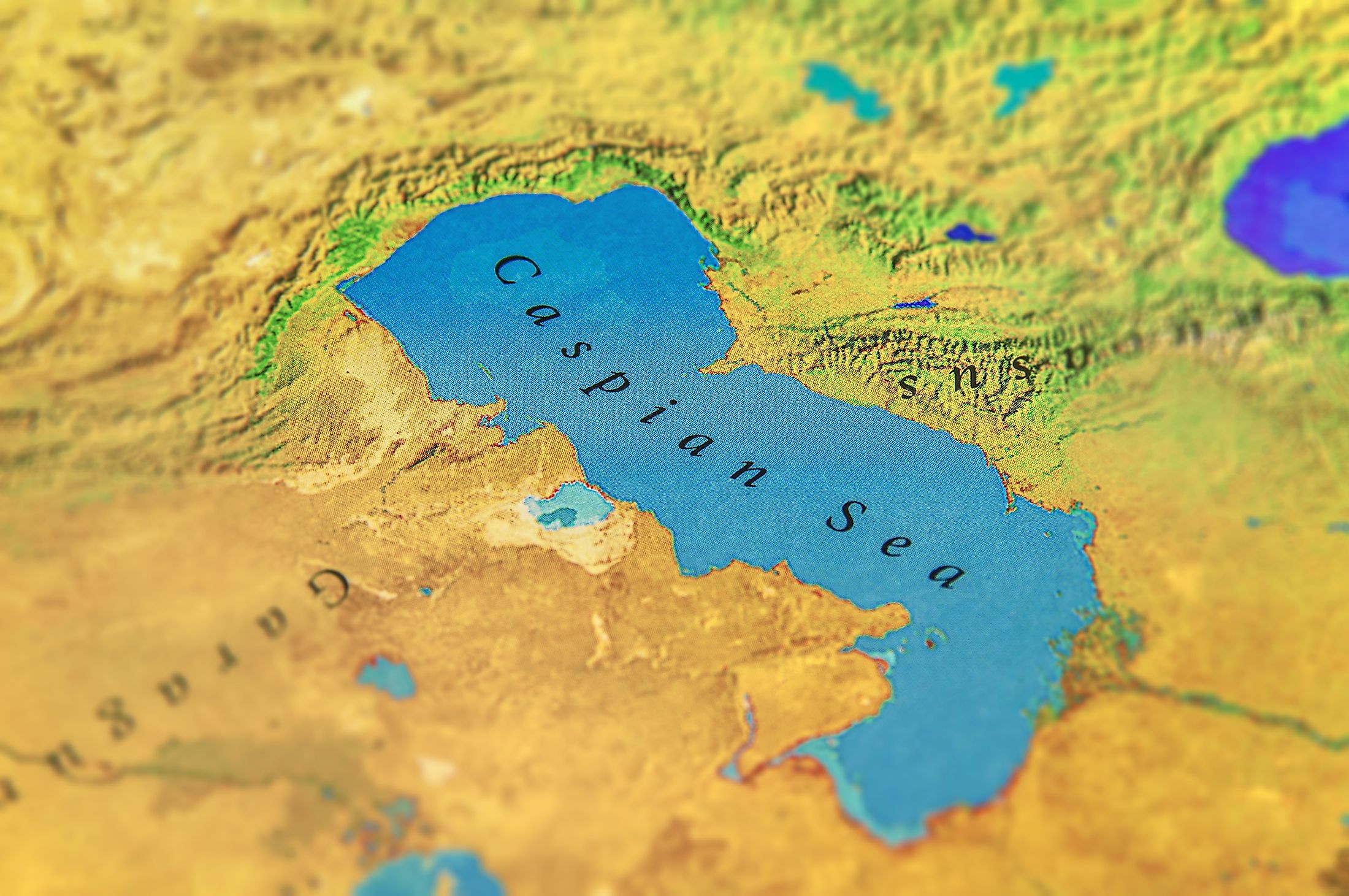
Caspian Sea
The Caspian Sea is the world’s largest water body that is enclosed or bordered by land on all sides. This massive lake is located between Asia and Europe.
The Caspian Sea may have derived its name from the Caspi people who lived in South Caucasus. However, the Persians and Greeks referred to the sea as the Hyrcanian Ocean.
The Caspian Sea is best known for its oil industry and caviar. It is also home to numerous plant and animal species. However, pollution, particularly from the oil industry, is a primary threat to the sea’s ecology, with environmental bodies calling for controlled industrial activities in the region.
Where Is The Caspian Sea?
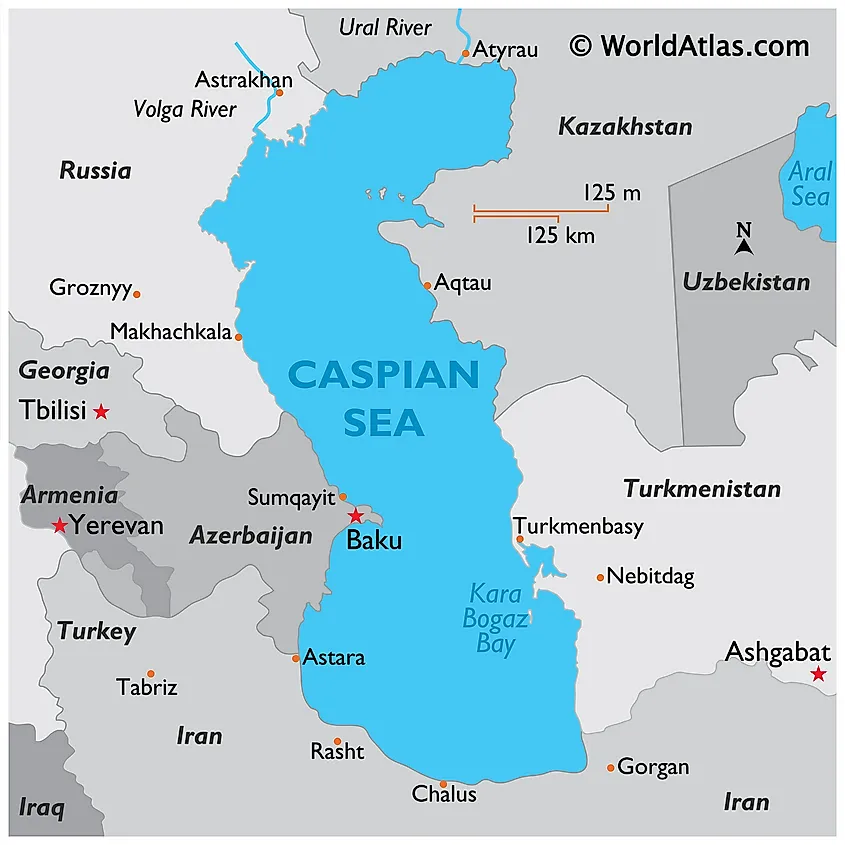
The Caspian Sea is an endorheic basin (drainage basin without an outflow). It covers a total surface area of about 386,400 km2 and is about 1,200 km long and 320 km wide. The sea’s surface is approximately 27 m below sea level and has a volume of 78,200 km3. The Caspian Sea accounts for between 40-44% of the world’s lacustrine waters.
Five countries in Asia and Europe share the Caspian Sea’s coastline. It is bordered to the north and east by Kazakhstan and from north to the west by Russia. Azerbaijan borders the sea to the southwest, while Iran is in the south. Turkmenistan lies along the southern portion of the eastern coast. Besides the five countries bordering the sea, the Caspian Sea drains Armenia, the eastern part of Georgia, the western portion of Uzbekistan, and the northeastern part of Turkey.
The Caspian Sea consists of three separate regions, namely Southern, Northern, and Middle Caspian. The Mangyshlak Threshold forms the Middle-Northern boundary, while the Apsheron Threshold separates the Southern from the Middle Caspian. The Northern Caspian is a shallow region with an average depth of between 5 and 6 meters. It carries less than 1% of the sea’s volume. The Middle Caspian is about 190 meters deep, while the Southern Caspian is the deepest region, about 1,000 meters deep. The Southern region accounts for 66%, while the Middle region accounts for 33% of the total water volume.
Is The Caspian Sea A Lake?
Going by the definition of a sea, the Caspian Sea is a lake and not a sea as it is an enclosed water body without any direct outlet to the ocean. However, 5.5 million years ago, it was part of the ancient Parathethys Sea and got landlocked as a result of tectonic uplift and sea-level fall. Hence, the seafloor of the Caspian Sea is composed of oceanic basalt and not continental granite. The Caspian Sea is also massive and forms waves like the sea along its shores. The composition of the water of the Caspian Sea also varies from almost fresh in the northern parts of the lake to saltier southwards. The mean salinity of the Caspian Sea is now about one-third that of the oceans.
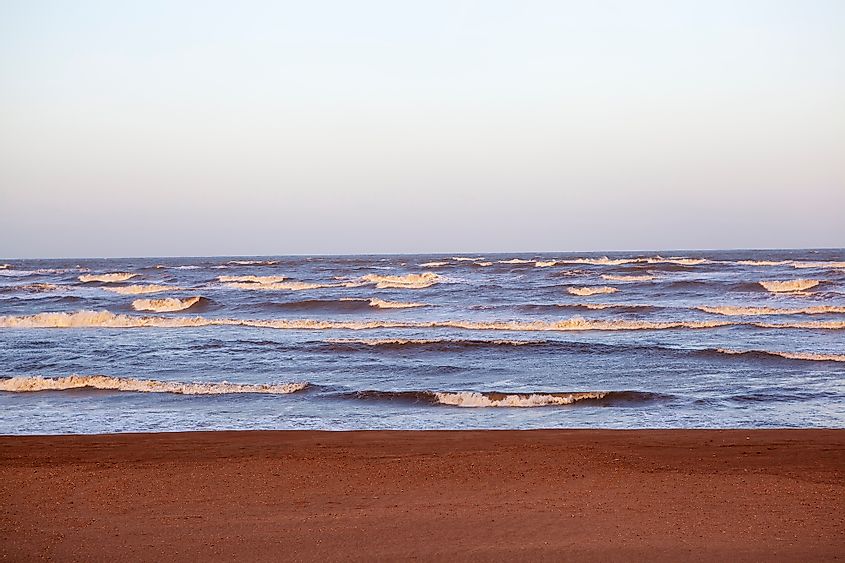
Is The Caspian Sea A Freshwater Or Saline Water Body?
Although most sources consider the Caspian Sea the world’s largest lake, it is not the largest freshwater lake. It can be classified as a brackish water body. The water in the Caspian Sea is neither completely freshwater nor completely saline water. The water is 1.2% saline. The Caspian’s mean salinity is about one-third the salinity of the oceans.
About 5.5 million years ago, the Caspian Sea was part of the Tethys Ocean but was completely cut off from the ocean due to plate tectonic. The sea became landlocked, without any outflow. Therefore, any water that gets into the sea, is either absorbed into the ground or evaporates, leading to the water becoming saline.
The Caspian Sea is not uniformly saline. The Iranian shore is more saline than the sea’s northern portion. The Caspian’s northern portion contains considerably freshwater because of the inflow of freshwater. Over 100 rivers empty into the Caspian Sea, including the Volga River, Europe’s largest river. Other rivers that flow into the Caspian are Amu Darya, Kura, and Ural Rivers. Most of these rivers contain fresh water and flow into Caspian from the north, making the sea’s northern portion less saline.
Islands In The Caspian Sea
The Caspian Sea contains about 50 small islands. These islands have a total land area of approximately 2,000 km2 and are mainly located on the sea’s northern portion. Most of the Caspian Sea islands lie off the coast of Baku Bay, Azerbaijan.
The largest island in the Caspian Sea is the Orguja Ada. It is a long, narrow desert island, running 42 km from north to south with a maximum width of about 1.5 km. Orguja Ada is also Turkmenistan’s largest island. The island has no permanent inhabitants. Other islands in the Caspian Sea include Durneva, Chechen, Buyuk Zira, Pirallhi, Bulla, Qum, Gil, and Chikil. None of these islands are inhabited.
The Climate Of The Caspian Sea
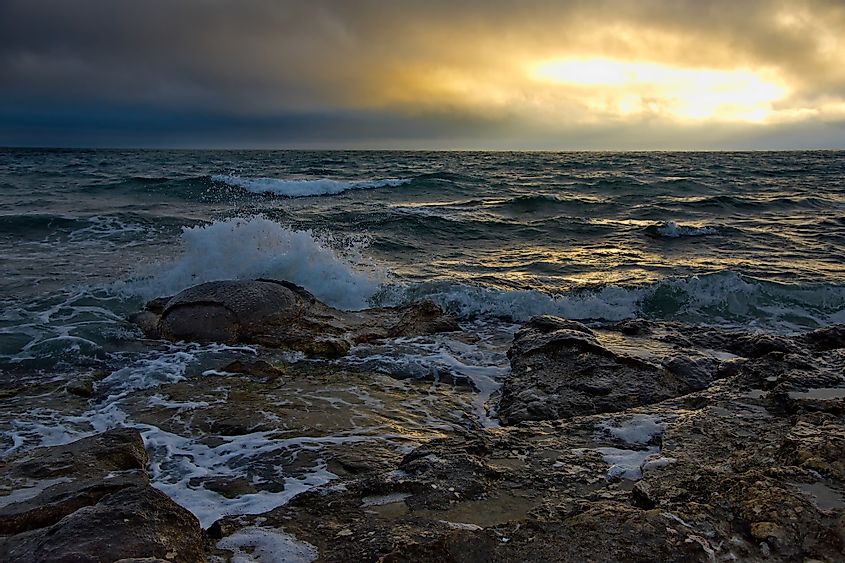
The Caspian Sea region is one of the world’s dry regions. The large water body crosses more than one climate region. The different climate regions coincide with the climate of the various countries sharing the sea’s coastline. The extreme north, which falls within Kazakhstan and Russia experiences a cold and dry temperate continental climate. The sea’s southern part, shared by Azerbaijan, Turkmenistan, and Iran is much warmer.
The surface temperature over the Caspian Sea varies with the regions. However, the average temperature during summer is between 75 and 79 degrees Fahrenheit. July to August is the warmest period due to the high temperatures. Winter temperatures are significant but vary with the region. The temperature in the north ranges from 32 to 45 degrees Fahrenheit, while in the south the temperature ranges from 46 to 50 degrees Fahrenheit.
Brief History
The Caspian Sea was part of the Paratethys Sea, an ancient sea in the Tethys Ocean. Tethys Ocean existed over 60 million years ago and was connected to the Pacific and the Atlantic Ocean. Following a shift in continental landforms, the Tethys Ocean was disconnected from the two oceans. Much of its water evaporated, leading to the formation of the Black Sea, the Aral Sea, and the Caspian.
Archaeological evidence reveals that humans began settling along the Caspian Sea about 75,000 years ago. The Caspi Tribe, from which the name “Caspian” was derived, inhabited the northwestern shores. Although oil was discovered around the 10th century, the Europeans began exploring the region for oil around the 16th century. In 1820, the first offshore oil well was dug in the Caspian Sea.
The sea’s water levels have fluctuated over the years. Between the 19th and 20th centuries, the water level fluctuated by about 12 feet. The Caspian Sea has also caused several floods, including the 1977 flood, which caused massive destruction. The sea’s water levels have risen by about 7 feet in the last four decades,
Human Settlement Along The Caspian Sea
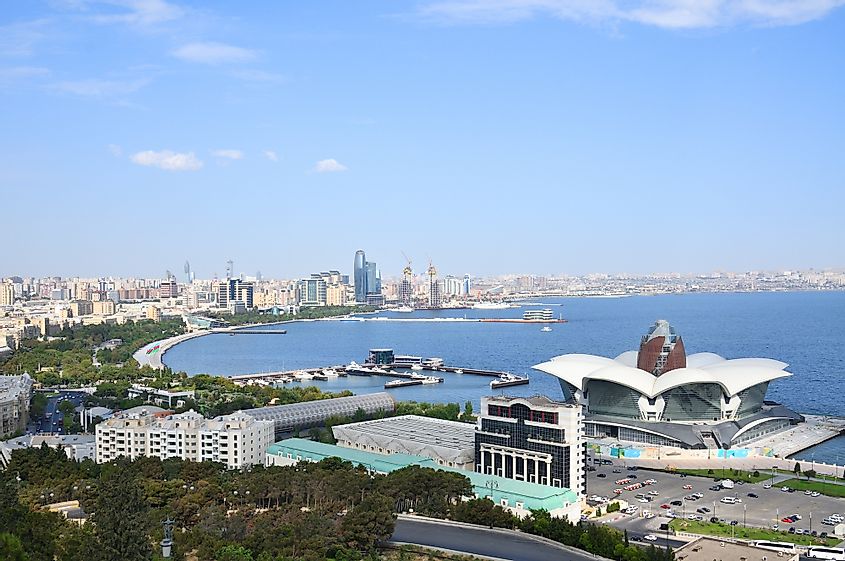
Several cities and towns are located along the Caspian Sea. These cities are home to thousands of people, many of which depend on the sea for their survival. Baku, the capital of Azerbaijan, is the largest city on the Caspian. It is home to some 2.2 million people. Another important city along the Caspian is Iran’s Nowshahr, with a population of about 50,000 people. Other cities include Ali Abad, Astara, Aktau, and Makhachkala.
Marine Life And Protected Areas
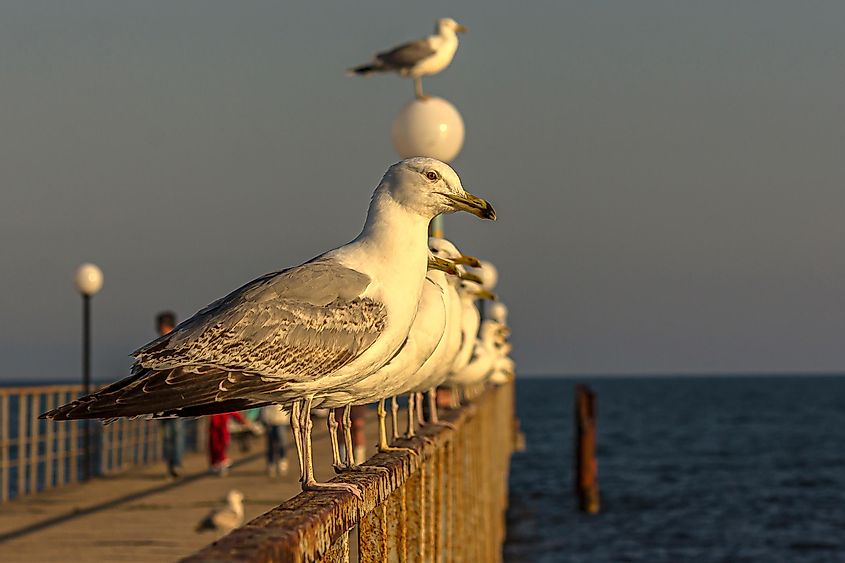
The Caspian Sea is rich in biodiversity and considered one of the world’s independent zoogeographical regions. It is home to some rare and endemic species. The shores also offer refuge for both plant and animal species. The shores have shallow saline pools that host small invertebrates, fish, and birds. Birds use the sea as a migratory route and refuge.
There are over 2,000 animals and species within the Caspian Sea region, of which 400 are endemic species. Some of these endemic species are the spur-thighed tortoise, Caspian gull, Caspian salmon, Caspian white fish, and Caspian Seal. Beluga sturgeon, known for its eggs, is the Caspian’s most valuable animals. They are the source of most of the world’s caviar. Other mammals found around the Caspian are the Asiatic lion, Asiatic tiger, and Caspian tiger. There are no sharks in the Caspian Sea.
The population around the sea is a source of ecological threat not only to the flora and fauna but also to the people who depend on the sea. Intensive oil exploration has caused serious pollution and harm to wildlife. However, addressing these threats is a challenge due to the dispute over the sea’s ownership among the five countries.
Economy
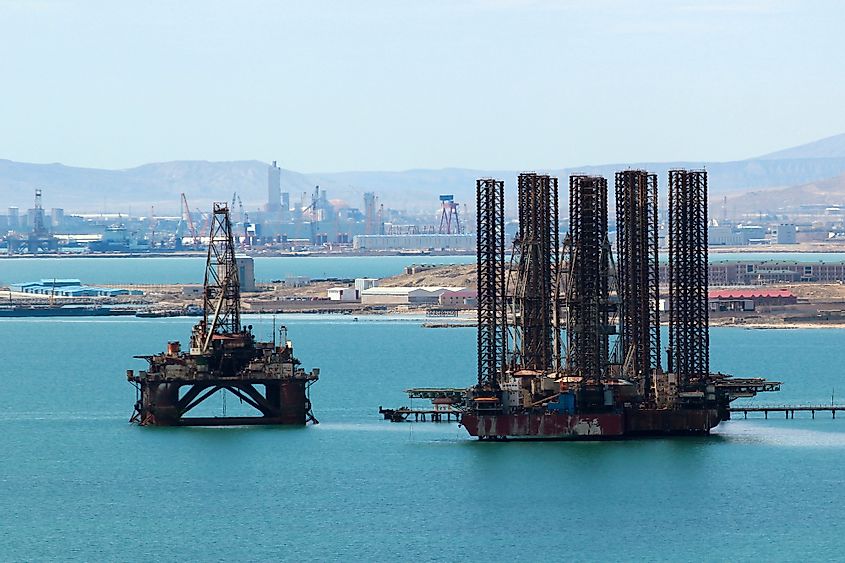
The Caspian Sea is a significant crude oil supplier. It produces about 1.5 million barrels of crude oil and natural gas per day, accounting for about 1.9% of the world’s total. Oil exploration in the region began in 1873. By 1941, Azerbaijan was producing about 23 million tons of oil annually. The Caspian economies export up to 80% of the total oil, with Russia exporting about 66% of the total oil export. Besides oil and gas, the Caspian Sea is an important trade route among the five countries. The Caspian Sea’s coastal areas also attract a significant number of tourists, generating additional income for the respective economy.
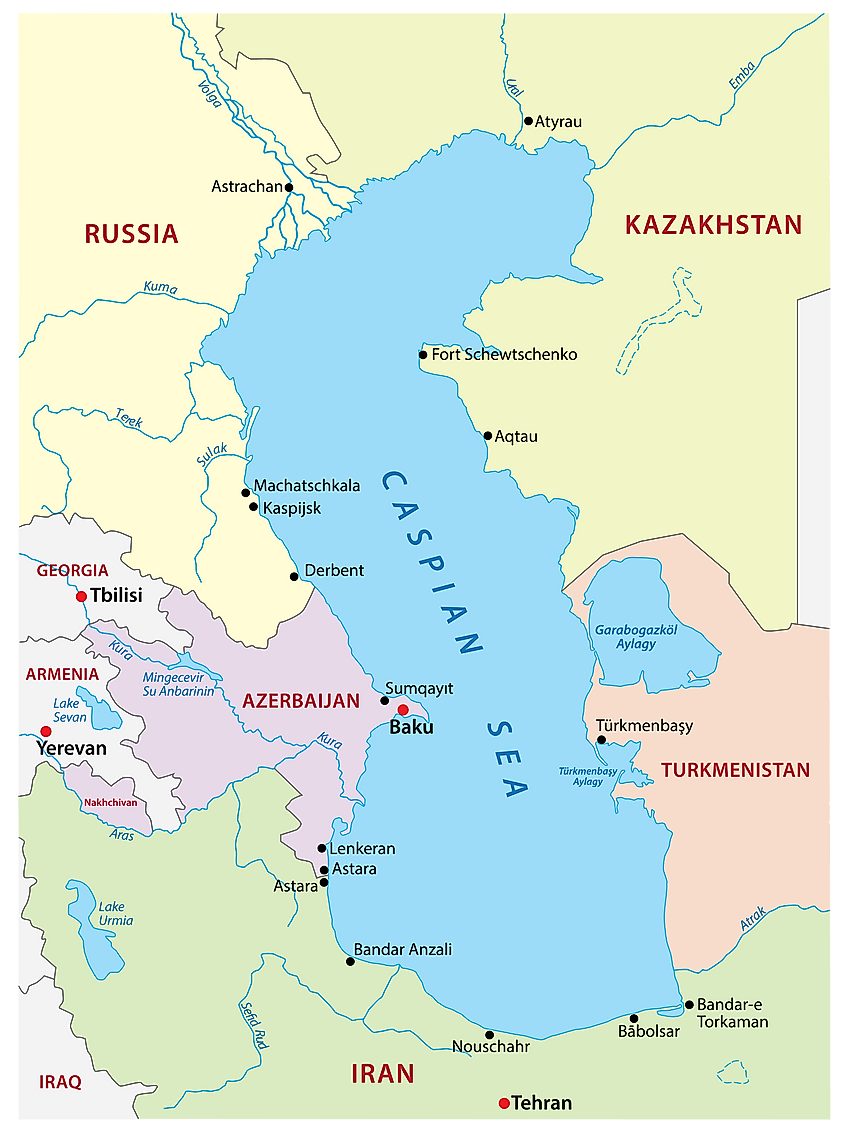
|
Feature |
Fact |
|
Surface Area |
386,400 km2 |
|
Maximum Depth |
1,025 m |
|
Average Depth |
211 m |
|
Length |
1,200 km |
|
Maximum Width |
435 km |
|
Minimum Width |
200 km |
|
Coastline Area |
6,820 km |
|
Water Volume |
78,200 km3 |
|
Altitude |
27 m below sea level |











